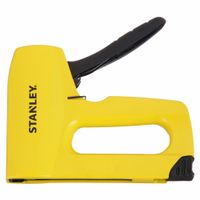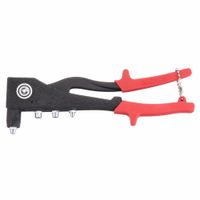Call +(254) 703 030 000 / 751 483 999 / 721 704 777
- Home
- Tools
- Hand Tools
- Hand Nailers Staplers Riveting Tools
.....Read More
Frequently Asked Questions
What are the differences between hand nailers, staplers, and riveters?
Hand nailers, staplers, and riveters are tools used for fastening materials, but they differ in their mechanisms and applications.
Hand Nailers: These tools drive nails into materials, typically wood. They can be manual or pneumatic. Manual hand nailers require physical force, while pneumatic versions use compressed air for efficiency and speed. Hand nailers are ideal for framing, roofing, and carpentry, providing strong, permanent holds.
Staplers: Staplers insert staples, which are U-shaped fasteners, into materials. They can be manual, electric, or pneumatic. Staplers are versatile, used in upholstery, carpentry, and office tasks. They are suitable for fastening thin materials like fabric, paper, or light wood. The hold is generally less permanent than nails, allowing for easier removal.
Riveters: Riveters insert rivets, which are metal pins or bolts, into materials. They can be manual, pneumatic, or hydraulic. Riveters are used in metalworking, automotive, and construction industries. Rivets provide a strong, permanent hold, ideal for joining metal sheets or heavy-duty materials. Unlike nails or staples, rivets require access to both sides of the material for installation.
In summary, hand nailers are best for strong, permanent wood connections, staplers are versatile for lighter materials, and riveters are ideal for durable metal fastening.
How do I choose the right hand tool for my fastening needs?
To choose the right hand tool for your fastening needs, consider the following factors:
1. **Type of Fastener**: Identify the fastener type (screws, bolts, nuts) you are working with. Use screwdrivers for screws, wrenches for nuts and bolts, and pliers for gripping.
2. **Size and Fit**: Ensure the tool matches the fastener size. Use adjustable wrenches for various sizes or a set of fixed-size wrenches. For screwdrivers, match the tip size and type (Phillips, flathead) to the screw.
3. **Material and Durability**: Choose tools made from durable materials like chrome vanadium steel for longevity. Consider corrosion-resistant coatings for tools used in humid environments.
4. **Ergonomics and Comfort**: Select tools with ergonomic handles to reduce hand fatigue. Look for non-slip grips for better control and comfort during extended use.
5. **Torque Requirements**: For tasks requiring specific torque, use torque wrenches to apply precise force. This is crucial for automotive or machinery work.
6. **Accessibility and Space**: Consider the working space. Use ratcheting wrenches or stubby screwdrivers in tight spaces. Long-handled tools provide better leverage in open areas.
7. **Frequency of Use**: For frequent use, invest in high-quality tools that offer durability and comfort. For occasional tasks, budget-friendly options may suffice.
8. **Special Features**: Look for tools with additional features like magnetic tips for screwdrivers or ratcheting mechanisms for wrenches to enhance efficiency.
9. **Brand and Warranty**: Opt for reputable brands known for quality. Check for warranties that offer protection against defects.
10. **Budget**: Balance quality with cost. Investing in a good set of basic tools can be more economical in the long run.
By considering these factors, you can select the most appropriate hand tool for your fastening needs, ensuring efficiency and safety in your tasks.
What types of fasteners can be used with hand nailers and staplers?
Hand nailers and staplers are versatile tools used in various applications, and they accommodate different types of fasteners:
1. **Nails**:
- **Brad Nails**: Thin, small-diameter nails ideal for delicate trim work and cabinetry.
- **Finish Nails**: Slightly thicker than brad nails, used for finishing work like molding and baseboards.
- **Framing Nails**: Larger nails used in construction for framing and structural work.
- **Roofing Nails**: Short nails with a large head, used for attaching shingles and roofing felt.
- **Concrete Nails**: Hardened nails designed for fastening into concrete or masonry.
2. **Staples**:
- **Standard Staples**: Used for general stapling tasks, available in various sizes.
- **Heavy-Duty Staples**: Thicker and longer, used for tougher materials like upholstery and carpet.
- **Cable Staples**: Designed to secure electrical cables without damaging them.
- **Insulated Staples**: Used for securing wires and cables, featuring a plastic coating to prevent damage.
- **T50 Staples**: A popular type of heavy-duty staple used in construction and upholstery.
3. **Pins**:
- **Headless Pins**: Used for delicate work where the fastener should be invisible, such as in fine woodworking.
4. **Tacks**:
- **Upholstery Tacks**: Short nails with a decorative head, used in furniture making and repair.
5. **Cleats**:
- **Flooring Cleats**: Used in flooring nailers for installing hardwood floors, available in L-shaped or T-shaped profiles.
Each type of fastener is designed for specific materials and applications, ensuring secure and efficient fastening.
How do I maintain and care for my hand nailer or stapler?
To maintain and care for your hand nailer or stapler, follow these steps:
1. **Regular Cleaning**: After each use, clean the tool to remove dust, debris, and any residue. Use a soft brush or compressed air to clean hard-to-reach areas.
2. **Lubrication**: Regularly lubricate the moving parts with a few drops of pneumatic tool oil. Focus on the air inlet and any other moving parts to ensure smooth operation and prevent rust.
3. **Check for Wear and Tear**: Inspect the tool for any signs of wear, such as damaged O-rings, seals, or springs. Replace any worn-out parts promptly to avoid further damage.
4. **Tighten Screws and Bolts**: Periodically check and tighten any loose screws or bolts to ensure the tool remains securely assembled.
5. **Inspect the Magazine**: Ensure the magazine is clean and free of obstructions. Check for any bent or damaged parts that could affect the feeding of nails or staples.
6. **Air Pressure**: Use the correct air pressure as specified by the manufacturer. Excessive pressure can damage the tool, while insufficient pressure can lead to poor performance.
7. **Storage**: Store the tool in a dry, cool place to prevent rust and damage. Use a protective case if available.
8. **Use Quality Fasteners**: Always use high-quality nails or staples that are compatible with your tool to prevent jams and ensure optimal performance.
9. **Follow Manufacturer’s Guidelines**: Adhere to the maintenance schedule and guidelines provided in the user manual for specific care instructions.
10. **Professional Servicing**: If the tool is not functioning properly despite regular maintenance, consider professional servicing to address any complex issues.
What safety precautions should I take when using hand fastening tools?
When using hand fastening tools, prioritize safety by following these precautions:
1. **Personal Protective Equipment (PPE):** Wear safety glasses to protect your eyes from flying debris. Use gloves to prevent cuts and improve grip, and wear appropriate footwear to protect your feet from dropped tools.
2. **Tool Inspection:** Before use, inspect tools for damage such as cracks, rust, or wear. Ensure that moving parts function smoothly and that handles are secure.
3. **Proper Tool Selection:** Use the right tool for the job. Avoid makeshift solutions, as using the wrong tool can lead to accidents or damage.
4. **Secure Work Area:** Ensure your work area is clean and well-lit. Remove any tripping hazards and secure materials being fastened to prevent movement.
5. **Correct Technique:** Use tools according to their design. Apply force in the intended direction and avoid overexertion. Maintain a firm grip and stable stance to prevent slips.
6. **Tool Maintenance:** Regularly clean and lubricate tools to ensure optimal performance. Sharpen cutting edges and replace worn parts as needed.
7. **Storage:** Store tools properly when not in use. Keep them in a dry, organized space to prevent damage and ensure easy access.
8. **Awareness of Surroundings:** Be mindful of others in the vicinity. Communicate clearly and ensure that bystanders are at a safe distance.
9. **Training:** Ensure you are trained in the proper use of each tool. Understand the specific risks associated with each tool and how to mitigate them.
10. **Emergency Preparedness:** Have a first aid kit readily available and know the location of emergency exits. Be familiar with basic first aid procedures in case of an accident.
By adhering to these precautions, you can minimize the risk of injury and ensure a safer working environment when using hand fastening tools.
Can hand riveters be used on all types of materials?
Hand riveters can be used on a variety of materials, but not all. They are most effective on materials that are relatively soft and thin, such as aluminum, steel, and certain plastics. These materials allow the rivet to expand and form a secure joint when the riveter is used.
However, hand riveters are not suitable for very hard or thick materials, such as hardened steel or thick metal plates, because the manual force applied may not be sufficient to properly set the rivet. In such cases, pneumatic or hydraulic riveters are more appropriate as they provide the necessary force to secure the rivet in tougher materials.
Additionally, hand riveters are not ideal for brittle materials like glass or ceramics, as the pressure applied during the riveting process can cause these materials to crack or shatter.
In summary, while hand riveters are versatile tools, their use is limited to materials that can be easily penetrated and deformed by the manual force they provide. For harder, thicker, or more brittle materials, alternative riveting methods or tools should be considered.
How do I troubleshoot common issues with hand nailers and staplers?
To troubleshoot common issues with hand nailers and staplers, follow these steps:
1. **Jamming**:
- **Cause**: Misaligned nails/staples or debris.
- **Solution**: Disconnect the tool from the air supply or power. Open the magazine and remove any jammed nails/staples. Clean the magazine and feed mechanism.
2. **Misfiring**:
- **Cause**: Incorrect air pressure or worn-out parts.
- **Solution**: Check and adjust the air pressure to the manufacturer's specifications. Inspect and replace worn or damaged parts like the driver blade or O-rings.
3. **Air Leaks**:
- **Cause**: Damaged seals or loose fittings.
- **Solution**: Inspect seals and O-rings for wear and replace if necessary. Tighten any loose fittings and connections.
4. **Weak Firing**:
- **Cause**: Low air pressure or clogged exhaust.
- **Solution**: Ensure the air compressor is set to the correct pressure. Clean the exhaust and air passages to remove any blockages.
5. **Double Firing**:
- **Cause**: Trigger sensitivity or worn trigger valve.
- **Solution**: Adjust the trigger sensitivity if possible. Replace the trigger valve if it is worn out.
6. **Skipping**:
- **Cause**: Incorrect nail/staple size or worn magazine.
- **Solution**: Use the correct size and type of nails/staples. Inspect the magazine for wear and replace if necessary.
7. **Tool Not Operating**:
- **Cause**: Power supply issues or internal damage.
- **Solution**: Check the power source and connections. Inspect the tool for internal damage and consult a professional if needed.
Regular maintenance, such as cleaning and lubrication, can prevent many of these issues. Always refer to the manufacturer's manual for specific troubleshooting and maintenance guidelines.

